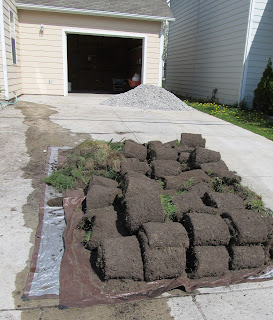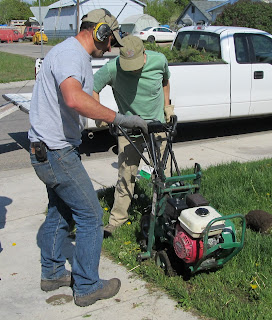FW: How to remove a lawn; part 2
SilverSage
Feed: Montana Wildlife Gardener
Spring is coming and I know a lot of people are thinking about expanding or planting a native plant garden. Inevitably the first question is about site preparation and, specifically what to do with the lawn that is between them and their wildlife and native plant garden destiny.
I thought I’d update the post with some more information and details based on questions I receive on this blog, in my speaking engagements and from mine and my wife’s native plant, wildlife and sustainable garden coaching business, Butterfly Properties (yes, my last name is German for "butterfly"). Like painting a house or so many other things, success is only guaranteed by the mundane tasks of preparation. Site preparation is the inglorious hard work that is the most important part, but often the part that gets short cut. And what is true for painting a house is true for gardening and native plant landscaping. Frustration, failure, dissatisfaction or disillusionment can often be traced back to skipping steps and taking short cuts in site preparation. In gardening terms, specifically in a native plant garden that comes down to getting rid of the existing lawn and keeping it out. In defense of the sod cutter. Sod cutters are hard to use, they are loud, they run on gas, and they are the best tool for the job. Although meticulously removing sod is always my suggestion, I am always met with questions where people would like an alternative. An alternative that many perceive is easier, more earth friendly, cheaper, quicker, etc... around here (Missoula) for the last few years, "lasagna" gardens or sheet mulching has become very popular. Initially popular, that is, it becomes very unpopular when people have to remove it, or deal with weeds in the lasagna. Typically what leads to failure is not giving the lasagna garden time enough to work, not dealing with the existing weeds, our climate, or a combination of the three. In my blog (and in our garden coaching business) I advocate for physically removing the lawn and I still do. This is the thing most people are resistant to do, but I think it is still the best and most effective way. It is also the quickest, and depending on you method, it could be the least resource intensive. You can dig it all up with a hand sod lifter or even a square bladed shovel and then compost it on site- This has to be one of the most, if not the most, resource un-intensive methods for lawn removal. Composting the sod does take time and a lot of space (depending on the quantity of sod you are removing). Also if you are going to go this route, dry the sod out (under a tarp or something and them screen the soil off first. What about solarizing? Using cardboard? Using a rototiller? Turning the sod upside down? There is always someone that will say it worked for them, but there are probably three other people out there that have a different experience. We have removed a lot of lawn, and the sod cutter (in one form or another) is always our method. My wife and I have landscaped public areas, little parks (like the Native Plant Garden at 8th and Grant), and other places that get very little maintenance, and the essential steps to ensuring that the areas stay weed free are below.
Is it hard to use a sod cutter? Yes. It takes work, depending on your soil (or lack of soil, like in many Missoula yards) it can be a beast of a job. I am not saying don’t do it, just be prepared. One of the biggest mistakes people make is removing too much soil, and this leads to a lot of extra work. It is critical to set the sod cutter at the proper depth- you don’t want to remove perfectly good soil, just get below the rooting depth of the grass. Although you can plant right away, it's better to wait and see what comes up. But don’t wait too long, because you will be inviting anything and everything from germinating. Is lawn edging necessary? Yes, unless you really enjoyed removing the sod and want to keep doing it for years to come. Edging is very effective, if installed correctly. Buy the biggest (deepest) kind possible. Aesthetically, metal edgings looks the best, steel or aluminum. Metal edging has the smallest profile and creates a nice clean look. Although I like steel the best, it is the most expensive and the hardest to work with. For most homeowners, I suggest plastic edging. The main criticism with plastic edging is from when it is improperly installed and it sits up too high. This is a problem for a several reasons. First, aesthetically, it is ugly. Second, if it is too high, it can work its way out of the ground through the freeze/ thaw cycle. Third it is ugly. Fourth, if it is set too high, it may allow rhizomes and runners to get underneath and invade the lawn-less area. Did I mention that if you set it too, high it is ugly? Just set the edging so it is just proud of the surface of the soil. If installed correctly, you shouldn't really notice it.
|




